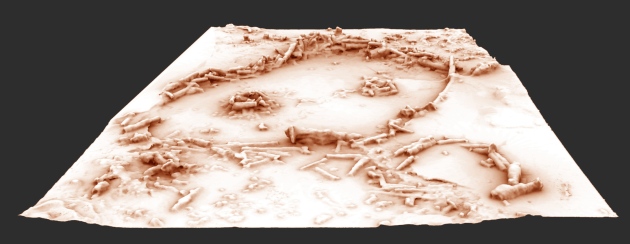Neanderthals built cave structures — and no one knows why
Neanderthals built cave structures — and no one knows why
Walls of stalagmites in a French cave might have had a domestic or a ceremonial use.
Neanderthals built one of the world’s oldest constructions — 176,000-year-old semicircular walls of stalagmites in the bowels of a cave in southwest France. The walls are currently the best evidence that Neanderthals built substantial structures and ventured deep into caves, but researchers are wary of concluding much more.
“The big question is why they made it,” says Jean-Jacques Hublin, a palaeoanthropologist at the Max Planck Institute for Evolutionary Anthropology in Leipzig, Germany who was not involved in the study, which is published online in Nature on 25 May 1. “Some people will come up with interpretations of ritual or religion or symbolism. Why not? But how to prove it?”
Nature Podcast
Speleologists first discovered the structures in Bruniquel Cave in the early 1990s. They are located about a third of a kilometre from the cave entrance, through a narrow passage that at one point requires crawling on all fours. Archaeologists later found a burnt bone from an herbivore or cave bear nearby and could detect no radioactive carbon left in it — a sign that the bone was older than 50,000 years, the limit of carbon dating. But when the archaeologist leading the excavation died in 1999, work stopped.
Then a few years ago, Sophie Verheyden, a palaeoclimatologist at the Royal Belgian Institute of Natural Sciences in Brussels and a keen speleologist, became curious about the cave after buying a holiday home nearby. She assembled a team of archaeologists, geochronologists and other experts to take a closer look at the mysterious structures.
Neanderthal hearths?
The six structures are made of about 400 large, broken-off stalagmites, arranged in semi-circles up to 6.7 metres wide. The researchers think that the pieces were once stacked up to form rudimentary walls. All have signs of burning, suggesting that fires were made within the walls. By analysing calcite accreted on the stalagmites and stumps since they were broken off, the team determined that the structures were made 174,400 to 178,600 years ago.

Early Neanderthal constructions deep in Bruniquel Cave in southwestern France
Jacques Jaubert, Sophie Verheyden, Dominique Genty, Michel Soulier, Hai Cheng, Dominique Blamart, Christian Burlet, Hubert Camus, Serge Delaby, Damien Deldicque, R. Lawrence Edwards, Catherine Ferrier, François Lacrampe-Cuyaubère, Frédéric Maksud, Pascal Mora, Xavier Muth, Édouard Régnier, Jean-Noël Rouzaud & Frédéric Santos
Nature (2016) doi:10.1038/nature18291





